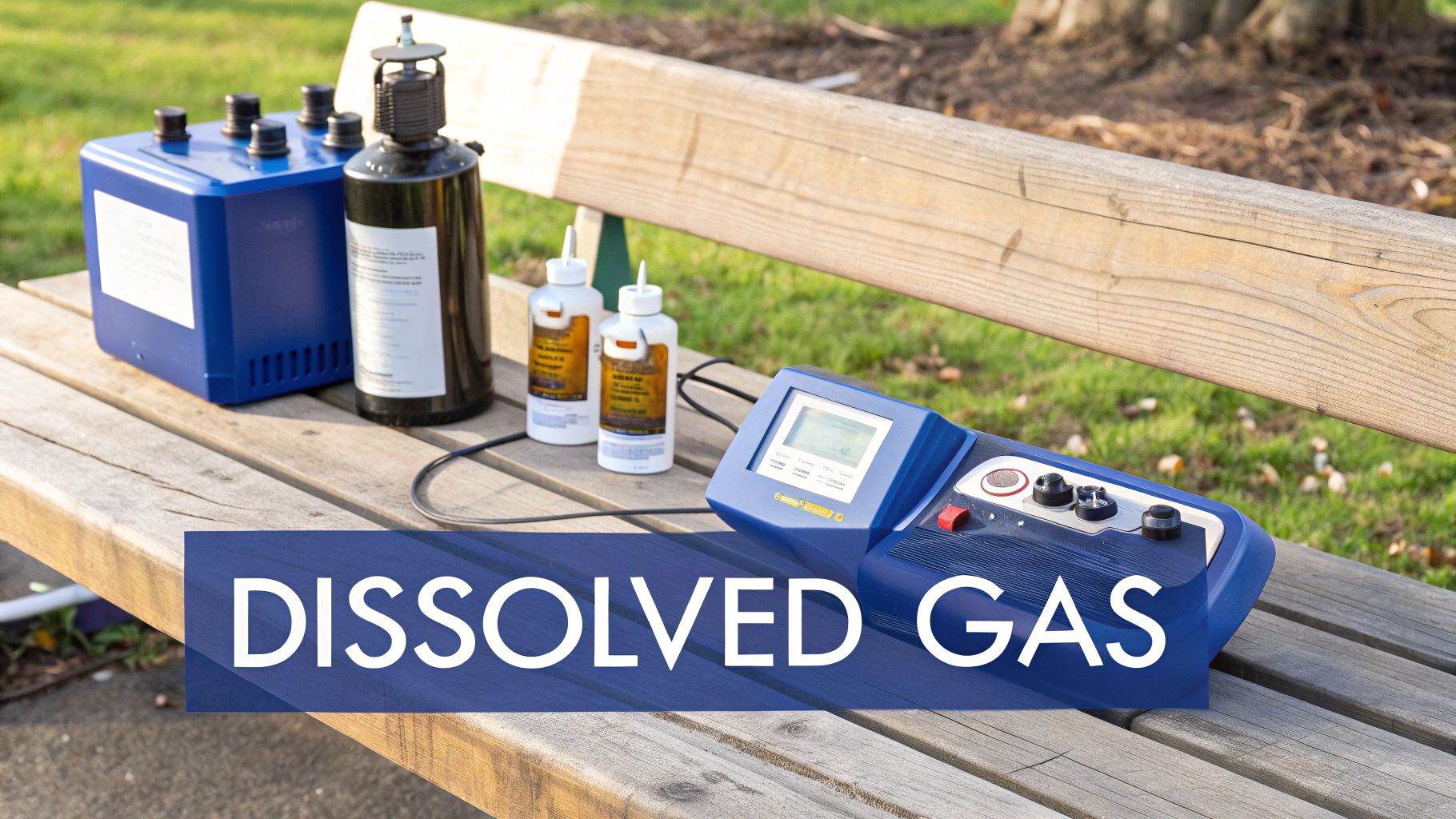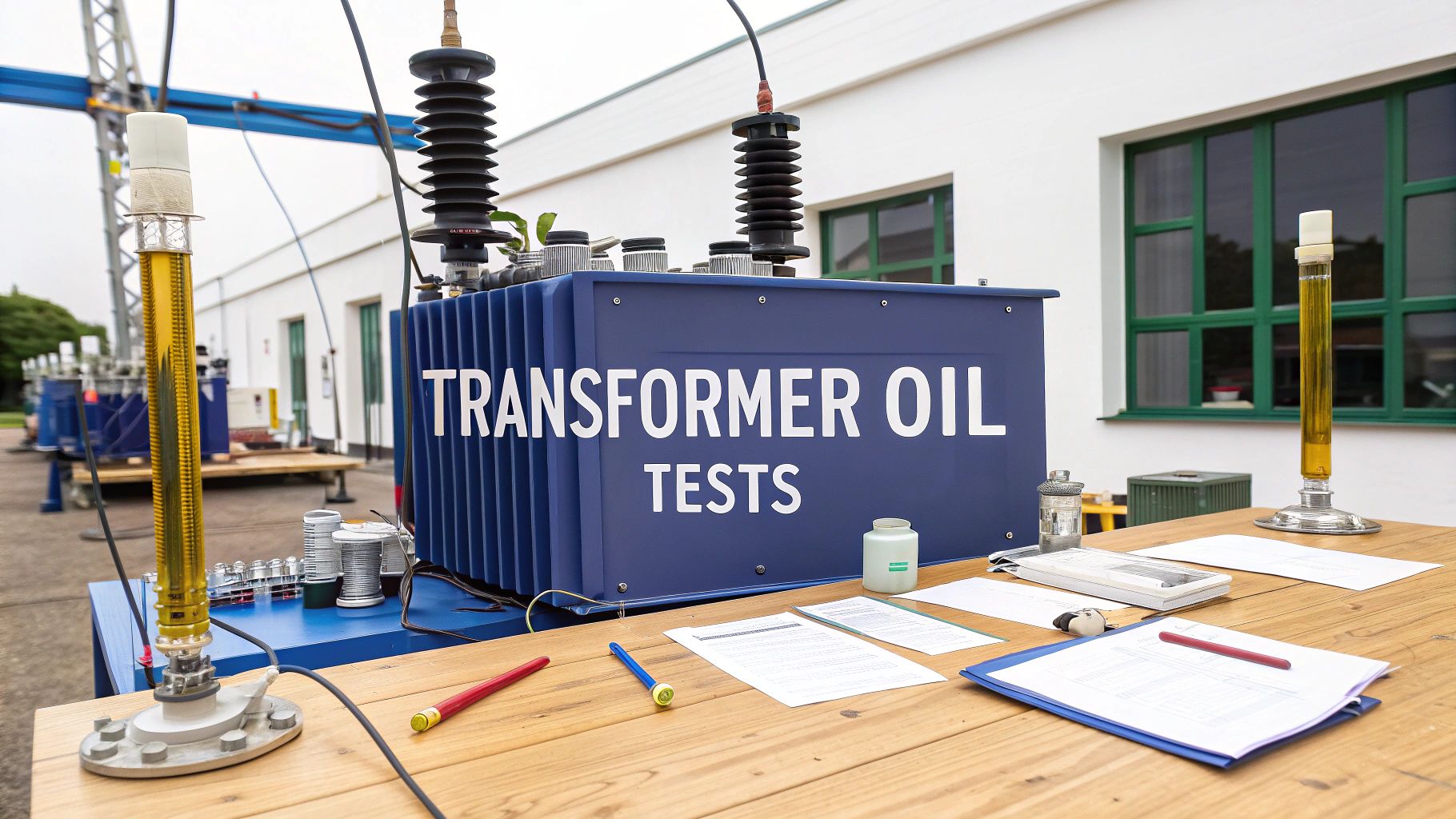For business decision-makers, transformer oil testing is a critical risk management tool, akin to a diagnostic health screening for your most vital electrical assets. This proactive process analyzes the oil’s physical and chemical properties to identify internal stresses and incipient faults before they escalate into catastrophic failures that halt operations.
Why Transformer Oil Testing Is a Cornerstone of Risk Management
For Texas industries—from sprawling petrochemical plants along the Gulf Coast to high-tech manufacturing facilities and agricultural operations—transformers are foundational to operational continuity. Their failure is not a minor inconvenience; it triggers immediate, costly shutdowns that can cascade across the entire supply chain.
The insulating oil within these assets serves as both a coolant and an insulator, but its most valuable function is as a diagnostic medium. Regular transformer oil tests are a key component of any modern predictive maintenance and operational risk management strategy. Instead of reacting to an equipment failure, this data-driven approach provides a clear snapshot of a transformer's internal health, revealing stresses from heavy operational loads or extreme Texas weather events.
The Strategic Value of Proactive Analysis
Implementing a routine oil testing program transitions an organization from a reactive to a proactive risk management posture. This strategic shift is fundamental to safeguarding operational continuity and financial stability.
The key benefits are data-driven and directly impact the bottom line:
- Prevent Catastrophic Failures: Early detection of warning signs like high moisture content, rising acidity, or internal arcing can prevent a complete equipment failure. This is a significant operational risk detailed in our guide on managing equipment breakdown.
- Minimize Unplanned Downtime: A scheduled, data-informed repair is exponentially less disruptive and costly than an emergency failure that halts production and impacts revenue.
- Extend Asset Lifespan: By maintaining oil integrity and addressing minor issues as they arise, companies can significantly extend the operational life of these high-value assets, maximizing their return on investment.
This forward-thinking approach is why the global transformer oil market is projected to reach USD 570.29 million by 2032. As Texas industries increase their reliance on stable power, the demand for intelligent asset management continues to grow, a trend noted by industry analysts at MarketResearch.com.
Disclaimer: The information provided in this guide is for educational and operational risk management purposes only. ClimateRiskNow does not sell insurance or financial products, and this content should not be interpreted as financial advice or an insurance recommendation. Our goal is to empower Texas business leaders with the data and insights needed to make informed decisions about mitigating operational risks.
To clarify the function of each primary test, the following table outlines their purpose and the specific risks they help mitigate.
Key Transformer Oil Tests and Their Purpose
| Test Name | Primary Purpose | Risk Mitigated |
|---|---|---|
| Dielectric Breakdown | Measures the oil's ability to withstand electrical stress | Prevents internal arcing and short circuits |
| Moisture Content | Detects the presence of water in the oil | Reduces risk of insulation degradation and electrical failure |
| Acidity (Neutralization) | Quantifies the level of acidic compounds from oxidation | Prevents corrosion of internal components and sludge formation |
| Dissolved Gas Analysis | Identifies gases produced by internal faults (e.g., overheating) | Early detection of incipient faults before they escalate |
| PCB Screening | Screens for the presence of Polychlorinated Biphenyls | Ensures environmental and regulatory compliance |
Each of these tests provides a unique piece of diagnostic data. Throughout this guide, we will examine each one, providing the actionable insights needed for informed decision-making.
Dielectric Strength and Moisture: Assessing Core Insulating Health
A transformer’s insulating oil is the primary barrier preventing high-voltage electrical arcs. The oil's ability to resist such an arc is its dielectric strength, one of the most vital indicators of its health and the transformer's immediate operational safety.

This test quantifies the maximum voltage the oil can withstand before it fails. A low dielectric strength value is a critical alert, signaling that the oil's insulating capability is compromised. This creates a significant risk of an internal short circuit, which can lead to catastrophic failure. For a Texas manufacturing plant, agricultural operation, or petrochemical facility, such an event translates to an immediate and costly operational shutdown.
Standardized Measurement for Reliable Data
To ensure consistent and reliable data for decision-making, testing relies on standardized methods from organizations like ASTM International. The two primary tests for dielectric strength are:
- ASTM D877: This method uses flat, disc-shaped electrodes and is effective at detecting contaminants like free water and solid particles that settle in the oil.
- ASTM D1816: A more sensitive test that uses rounded electrodes and agitates the oil sample. This allows it to detect dissolved water and finer contaminants, providing a more precise assessment of the oil's true insulating capacity.
A high value indicates the oil is clean, dry, and effectively protecting the transformer's core. A low value signals that a contaminant has breached the electrical insulation—and water is the most frequent culprit.
The Operational Risk of Moisture Ingress
Moisture is the primary adversary of transformer oil. Even trace amounts, measured in parts-per-million (ppm), can severely degrade the oil's dielectric strength. More insidiously, water accelerates the decay of the solid paper insulation wrapped around the transformer’s windings, making it brittle. Once this insulation is compromised, it cannot be repaired without a complete and costly transformer rebuild.
For industrial operations along the humid Texas Gulf Coast or in agricultural settings with high ambient moisture, preventing water ingress is a constant operational challenge. Regular moisture testing is not just a best practice; it is an essential component of asset preservation.
Water can infiltrate a transformer through aging gaskets, damaged seals, or improper maintenance procedures. The Karl Fischer (KF) titration test is the industry standard for accurately measuring its concentration.
The importance of maintaining oil integrity is reflected in market data; the global transformer oil market was valued at USD 2.65 billion in 2024 and is projected to reach USD 4.4 billion by 2033, driven by industrial demand and stricter reliability standards, as noted in this detailed market analysis.
Actionable thresholds for moisture content are clear:
- Good: New transformer oil should have a moisture content well below 20 ppm. In-service units should be maintained below 35 ppm.
- Action Required: Levels exceeding 50 ppm indicate a need for intervention, such as on-site oil dehydration to remove excess water.
By tracking both dielectric strength and moisture content, facility managers gain powerful diagnostic data to mitigate contamination risks before they lead to critical asset failure, thereby protecting operational uptime and the company's bottom line.
Tracking Chemical Health with Acidity and IFT
While dielectric and moisture tests assess physical contamination, other transformer oil tests monitor the oil's chemical degradation. Over time, exposure to heat and oxygen causes the oil to oxidize, creating acidic compounds that can corrode a transformer from within.

Acidity testing, also known as a neutralization number test, measures the concentration of these harmful acids. A low value indicates healthy oil, while a high value is a critical warning that the oil is rapidly aging and losing its protective properties. For a Texas manufacturing or logistics facility operating around the clock, high acidity poses a direct threat to operational continuity.
The Problem with High Acidity
Unchecked acidity is an active threat. These corrosive compounds attack the transformer's internal metal components and, more critically, accelerate the breakdown of the solid paper insulation.
This process ultimately forms a thick, varnish-like sludge that clogs cooling ducts, impeding thermal regulation.
When cooling is compromised, the transformer's operating temperature rises, which in turn accelerates the oxidation process, creating a dangerous feedback loop. This cycle is a leading cause of premature transformer failure. The primary risk management objective is to detect rising acidity levels early, before irreversible damage and sludge formation occur.
IFT: The Early Warning System
Interfacial Tension (IFT) serves as an early warning indicator of oil degradation. While acidity confirms advanced decay, IFT detects the initial stages of contamination. This test measures the tension at the boundary between oil and water.
Clean, healthy oil repels water, resulting in high interfacial tension. As polar contaminants and decay byproducts accumulate, this tension weakens, and the oil's ability to shed water diminishes.
A declining IFT value is one of the first signs of oil contamination and degradation. Critically, the IFT often drops significantly before the acidity number begins to rise, providing a valuable window for proactive maintenance planning.
Standardized test methods like ASTM D971 ensure these measurements are consistent and reliable, providing a clear, data-driven view of the oil’s condition. Our complete guide to transformer oil analysis offers a more in-depth look at building a comprehensive testing schedule.
Why Tracking Trends Is Crucial
No single test provides a complete picture. The true diagnostic power of acidity and IFT testing comes from tracking their trends over time. A single high acidity reading indicates a current problem. A consistent downward trend in IFT over several months signals a future problem, allowing time for proactive intervention.
This data-driven approach allows an organization to shift from reactive, emergency repairs to proactive, planned maintenance. By monitoring the relationship between these two values, decision-makers can accurately predict when oil may require reclamation (a purification process) or replacement. This enables scheduling work on the company's terms, avoiding the high cost and operational disruption of unplanned downtime—a vital risk management strategy for Texas's demanding industrial environments.
Uncovering Hidden Faults with Dissolved Gas Analysis
While other transformer oil tests serve as general health diagnostics, Dissolved Gas Analysis (DGA) provides a forensic-level examination of a transformer's internal condition. It is the single most powerful diagnostic tool for detecting incipient faults caused by severe electrical and thermal stress. This test doesn't just indicate a problem; it provides actionable intelligence on the specific nature and severity of the fault.
As transformer oil degrades under fault conditions, it releases specific gases. Each type of internal fault—such as chronic low-temperature overheating versus a sudden high-energy arc—produces a unique combination of gases. By analyzing the types and concentrations of these gases, hidden problems can be identified long before they lead to a catastrophic failure.
Interpreting Gaseous Fingerprints
The DGA process involves extracting an oil sample and using gas chromatography to separate and measure dissolved gases, often to a precision of parts-per-million (ppm). Certain gases are direct indicators of specific fault types.
Key fault gases include:
- Hydrogen (H₂): Often the first gas to appear, indicating partial discharges (corona)—a low-level electrical discharge that slowly degrades insulation.
- Methane (CH₄) & Ethane (C₂H₆): These gases suggest low-temperature overheating, typically below 300°C, which could signal overloaded conductors or a poor connection.
- Ethylene (C₂H₄): Indicates higher temperatures, generally between 300°C and 700°C, signaling more serious thermal degradation of insulation.
- Acetylene (C₂H₂): The presence of acetylene is a critical warning. It is produced only at extremely high temperatures (over 700°C) and is the definitive sign of high-energy arcing, a direct precursor to a major failure.
The infographic below illustrates the importance of proper sample collection, which is the foundational step for obtaining accurate DGA results.
This map underscores that accurate analysis depends entirely on disciplined procedures for sampling, collection, and handling. Any procedural error renders the laboratory results invalid for decision-making.
Data Interpretation Using the Duval Triangle
Detecting fault gases is only the first step; analyzing their ratios provides true diagnostic power. The industry-standard method for this is the Duval Triangle, a graphical tool that uses the percentage of methane, ethylene, and acetylene to pinpoint the exact fault type.
By plotting these gas concentrations, an analyst can distinguish between seven different fault conditions, including partial discharges, thermal faults of varying temperatures, and low- or high-energy arcing. This level of diagnostic precision is unmatched.
For a Texas energy or manufacturing company, this methodology transforms risk assessment from educated guesswork to data-driven certainty. The Duval Triangle can differentiate between a minor issue requiring monitoring and a critical arcing fault that necessitates an immediate, planned shutdown to prevent an explosion.
This level of detailed asset management is increasingly vital. The global transformer oil market, which enables this testing, was valued at USD 2.73 billion in 2023 and is projected to reach USD 6.12 billion by 2030. This growth reflects a global initiative to modernize electrical grids and secure industrial power reliability, a trend analyzed by Grand View Research.
The table below offers a simplified interpretation of how specific gases relate to internal transformer conditions.
Interpreting Fault Gases in Dissolved Gas Analysis
| Fault Gas | Associated Fault Type | Typical Concern Level |
|---|---|---|
| Hydrogen (H₂) | Partial Discharge (Corona) | Low to Medium |
| Methane (CH₄) | Low-Temperature Overheating | Medium |
| Ethylene (C₂H₄) | High-Temperature Overheating | High |
| Acetylene (C₂H₂) | High-Energy Arcing | Critical |
While this provides a general guide, a definitive diagnosis relies on analyzing the ratios of these gases to understand the fault's severity and nature.
Case Study: A Texas Manufacturing Plant Averts Disaster
A large manufacturing facility near Houston conducted its annual DGA as part of a routine maintenance program. For years, results for its main production transformer were normal. This time, the lab detected a sudden spike in acetylene and hydrogen.
Duval Triangle analysis pointed directly to a high-energy arcing fault. Although the transformer exhibited no external symptoms, the DGA data was an undeniable warning of imminent failure.
Armed with this data, the plant's leadership scheduled an immediate, planned shutdown. An internal inspection revealed a severely degraded connection on a high-voltage winding that was actively arcing. Left unaddressed, it would have failed catastrophically, likely causing a fire, extensive equipment damage, and millions in lost production. DGA enabled the company to avert a multi-million-dollar disaster with a scheduled repair.
Managing Contaminants and Regulatory Compliance
Certain transformer oil tests extend beyond operational performance to address environmental safety and regulatory compliance. While oxidation and moisture are operational concerns, specific chemical contaminants can create significant legal and financial liabilities, particularly for Texas industries with legacy electrical equipment.
The most prominent of these is Polychlorinated Biphenyls (PCBs). Banned in 1979, these synthetic chemicals were previously used in transformer oil for their excellent insulating and fire-resistant properties. However, they are highly toxic and environmentally persistent.

Navigating EPA Regulations for PCBs
The U.S. Environmental Protection Agency (EPA) enforces strict regulations for PCBs under the Toxic Substances Control Act (TSCA), governing their handling, storage, and disposal. For businesses in established Texas sectors like petrochemicals, manufacturing, and agriculture, there is a tangible risk that older transformers may still contain PCBs. Non-compliance can result in severe penalties.
A simple screening test provides the necessary data to determine compliance status. PCB concentration is measured in parts per million (ppm).
- Non-PCB: Oil with less than 2 ppm of PCBs is considered clean.
- PCB-Contaminated: Oil with PCB levels between 2 ppm and 499 ppm is subject to specific handling and disposal regulations.
- PCB Transformer: Equipment with oil containing 500 ppm or more falls under the EPA's most stringent regulations, which mandate specific labeling, inspection schedules, and detailed record-keeping.
Identifying and managing these assets is a critical component of corporate risk management and is foundational to any strategy for critical infrastructure protection.
For any business leader, a positive PCB test requires immediate and specific compliance actions. Understanding the status of your equipment is essential for avoiding regulatory fines and managing assets safely and responsibly.
The Impact of Solid Contaminants and Sludge
Beyond regulated chemicals, physical contaminants in oil pose a direct threat to equipment reliability. Solid particles—such as dust, insulation fibers, or metal shavings—are circulated by the oil and degrade its performance.
First, these particles reduce the oil's dielectric strength by creating pathways for electricity to arc, significantly increasing the risk of an internal short circuit.
Second, these solids, along with sludge from severe oil oxidation, can obstruct the transformer's cooling system. They accumulate in cooling ducts and on radiator surfaces, acting as an insulating barrier that prevents proper heat dissipation.
The result is a transformer that operates at dangerously high temperatures. This constant overheating accelerates the aging of the oil and paper insulation and can lead to thermal runaway—a vicious cycle where increasing heat causes further breakdown, generating more heat and leading directly to catastrophic failure.
Regular testing for these contaminants and their removal through filtration or oil reclamation is not merely routine maintenance; it is a fundamental strategy for ensuring asset reliability, workplace safety, and operational continuity.
Building Your Proactive Oil Testing Program
Understanding the individual transformer oil tests is the first step. The next is to integrate this knowledge into a structured, proactive testing program. The goal is not to run every possible test but to build a data-driven schedule tailored to your specific equipment and operational risks.
A well-designed program transforms maintenance from a reactive, unpredictable expense into a strategic investment in operational reliability.
The foundation is a clear schedule based on industry guidelines, such as those from the IEEE, but customized to your operational context.
- Transformer Age: Older units require more frequent testing, as insulation and oil naturally degrade over time.
- Criticality: A main production transformer at a Texas petrochemical plant warrants more rigorous annual testing than a non-critical lighting transformer.
- Operating Environment: Equipment exposed to the high humidity of the Gulf Coast or the extreme heat of West Texas is under greater stress and requires closer monitoring.
The Foundation of Reliable Data
The most sophisticated analysis is rendered useless if the oil sample is contaminated during collection. Proper sampling is a non-negotiable prerequisite for obtaining actionable data.
This requires trained personnel using clean, dedicated equipment to draw a sample that accurately represents the oil inside the transformer. A flawed sample leads to wasted resources and a false sense of security. Adherence to strict procedures, like those detailed in guides for SOPs for Electrical Maintenance Departments, is essential for data integrity.
The core principle of a successful program is trend analysis. A single test result is a snapshot. A series of results over months or years provides a comprehensive view of the transformer's health, revealing trends like accelerating decay long before a single reading crosses an alarm threshold.
Selecting the Right Testing Partner
Choosing a qualified third-party laboratory is as critical as the tests themselves. A reliable partner delivers accurate, repeatable results that can be used to make confident maintenance decisions.
Key criteria for vetting a laboratory include:
- Accreditation: ISO accreditation provides third-party validation of their quality control processes.
- Turnaround Time: The ability to provide rapid results is crucial when a potential fault is suspected.
- Reporting and Support: Reports should be clear, concise, and include professional interpretations, with experts available for consultation.
- Industry Experience: A lab with deep experience in the Texas industrial sector will understand the unique operational and environmental challenges your assets face.
Ultimately, a data-driven approach to transformer oil testing is fundamental to modern asset management. It delivers the actionable intelligence required to mitigate risks, prevent costly failures, and ensure operational continuity. For a broader perspective on how this fits into a comprehensive strategy, review our guide on what operational risk management is.
Frequently Asked Questions About Transformer Oil Tests
For Texas business leaders, implementing a testing program often raises practical questions. Here are concise answers to the most common inquiries regarding the application of transformer oil tests.
How Often Should We Test Our Transformer Oil?
There is no universal schedule. Testing frequency should be based on the transformer's age, voltage rating, and its criticality to your operations. A high-voltage unit powering a critical petrochemical process requires comprehensive annual testing, including DGA.
Conversely, a less critical transformer may only require basic screening every two to three years. Always consult the manufacturer's recommendations and industry standards (e.g., IEEE) as a baseline. However, any significant electrical event or abnormal equipment behavior should trigger immediate testing to assess for potential internal damage.
What Is The Difference Between Screening Tests and DGA?
Screening tests are analogous to a general health checkup. They assess the oil's basic vital signs—dielectric strength, moisture, and acidity—to provide a high-level assessment of its fitness for service.
Dissolved Gas Analysis (DGA), in contrast, is a specialized diagnostic tool, like an MRI for your transformer. DGA identifies specific gases that are only generated by internal faults, such as arcing or severe overheating. It doesn't just confirm that a problem exists; it provides actionable data on the type and severity of the problem.
Can We Perform These Tests In-House?
While simple, portable kits are available for field-screening of dielectric strength, their accuracy is limited. To obtain reliable, decision-grade data, most tests must be performed in a controlled laboratory environment.
For advanced diagnostics like DGA, Karl Fischer moisture, and acidity tests, partnering with an accredited third-party laboratory is the industry best practice. This is the only way to ensure results are sufficiently accurate to support high-stakes maintenance and operational decisions.
What Does A Negative Test Result Mean for Operations?
An adverse test result is a data point for action, not necessarily an indication of imminent failure. The required response depends on the specific test. For example, high moisture may necessitate scheduling on-site oil processing. Rising acidity signals oil degradation that may require future reclamation.
The most critical results often come from DGA. The detection of certain gases, like acetylene, could trigger an immediate, planned shutdown to prevent a catastrophic failure. The objective is to use this data to transition from reactive, emergency repairs to proactive, planned maintenance, thereby reducing unplanned downtime and mitigating operational risk. Understanding how to manage these risks is a key theme in our discussion on equipment breakdown coverage.

